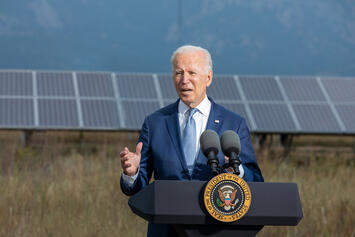
President Biden recently issued a 5,400-word executive order directing all federal agencies to emphasize “environmental justice” in every decision they make.
After ducking questions for weeks on what remediation, remuneration and environmental justice the administration is providing East Palestine, Ohio residents following a toxic railway chemical spill, White House Press Secretary Karine Jean-Pierre explained the EO in her inimitable style:
The President has “the most ambitious climate agenda than any other president in history, and one way that you can look at this today is that he’s continuing to deliver on that ambitious agenda, and he’s not done yet. This is a continuing continuation of what he’s promised the American people.”
In plain English, the order enables each agency to implement this infinitely malleable “justice” concept to justify whatever policies and regulations it is implementing in the name of abating the “climate crisis” and “fundamentally transforming” America’s energy and economic systems. It also allows agencies to ignore any “justice” issues that might interfere with their plans.
The Environmental Protection Agency quickly issued a press release citing justice and “equity” rationales for eliminating coal and gas power plants, internal-combustion vehicles, and gas stoves, ovens, furnaces and water heaters – all of which it says contribute to global warming.
EPA claims “children are uniquely vulnerable” to climate-related impacts like rising temperatures that can cause “lifelong consequences” for their concentration, learning, academic achievement and earnings potential. Moreover, these effects “disproportionately fall on children who are Black, Indigenous and People of Color, low income, without health insurance, and/or have limited English proficiency.”
Of course, air conditioning reduces high temperatures in schools and homes, thereby avoiding these far-fetched problems. During wintertime, gas furnaces (or reliable, affordable coal or gas-generated electric heat) keep students warm when outdoor temperatures plummet to deadly lows.
However, both cooling and heating systems will become unavailable or unaffordable to these same classes of people in the wake of government decrees that coal and gas be banished, and electricity provided by expensive, weather-dependent wind and solar. That’s already happening in Europe.
The Economist reported that 68,000 people died in Europe this past winter because energy prices have rocketed so high that many families can no longer afford to heat their homes properly.
Meanwhile, EPA asserts that closing coal and gas power plants would prevent 1,300 “premature deaths” by 2042 from global warming. That’s a hypothetical 65 deaths annually.
Allowing for Europe versus US population differences, more than 30,000 Americans would die needlessly every year, if energy prices soar as high as they have in Europe. Minority and low and middle income families would be disproportionately affected and least able to afford proper winter heating. Without affordable, dependable AC, thousands more would likely die during sweltering summers. Just keeping lights on and computers running requires reliable, affordable electricity.
Read the rest of this piece at Townhall.
Paul Driessen is senior policy advisor for the Committee For A Constructive Tomorrow (www.CFACT.org) and author of books, reports and articles on energy, environmental, climate and human rights issues.
Photo: NREL via Flickr under CC 2.0 License.












